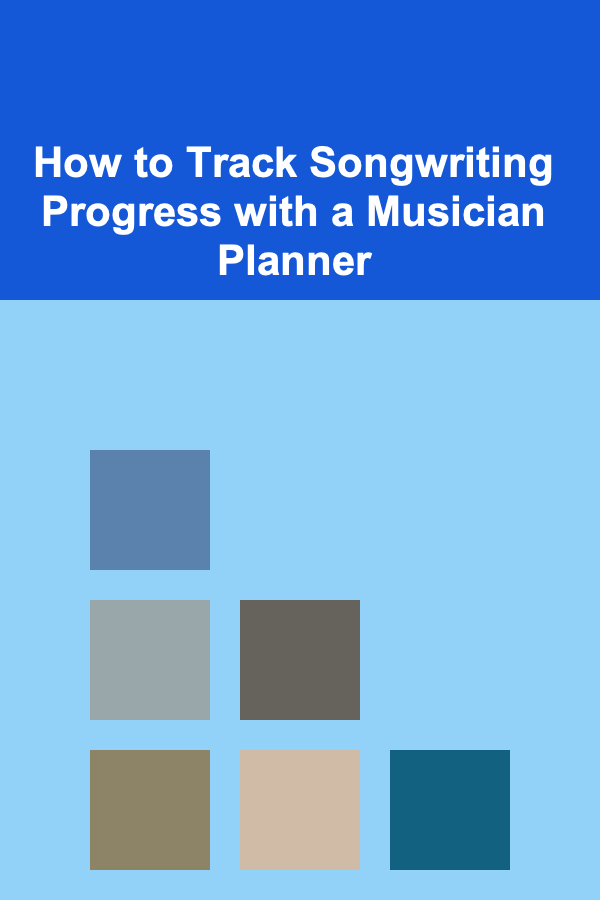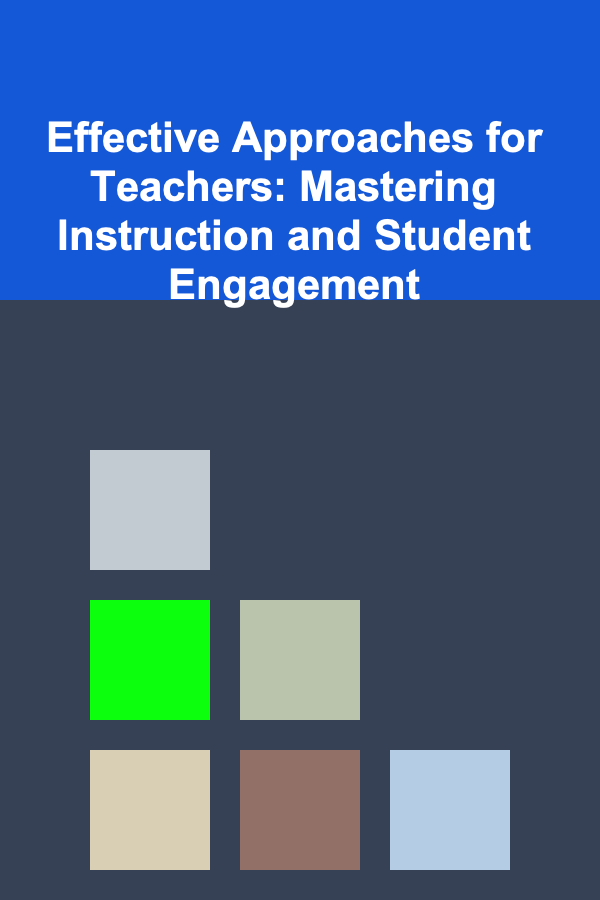
How to Track Songwriting Progress with a Musician Planner
ebook include PDF & Audio bundle (Micro Guide)
$12.99$11.99
Limited Time Offer! Order within the next:

Songwriting is a deeply creative process that requires inspiration, dedication, and often, a lot of time. Whether you're a seasoned musician or a beginner, tracking your progress can help you stay focused, measure improvement, and ensure you stay on track to meet your songwriting goals. One powerful tool that can facilitate this is a musician planner.
In this article, we'll explore how to use a musician planner effectively to track your songwriting progress. From brainstorming ideas to finalizing your tracks, we'll cover the key components of the songwriting journey and how you can break down each stage into manageable tasks. By the end, you'll have a clear understanding of how to implement a planner into your songwriting routine to keep you organized, motivated, and productive.
Understanding the Songwriting Process
Before we dive into how to track your progress, it's important to understand the steps involved in songwriting. Every musician has a unique approach, but generally, the process follows a similar path:
1.1. Inspiration & Idea Generation
Songwriting begins with an idea. This could be a melody, a lyric, a chord progression, or even an emotional experience that you want to express through music. Inspiration can strike at any moment, and it's important to be prepared to capture these ideas as they come to you.
1.2. Development & Composition
Once you have a seed of an idea, you move into the development phase. This stage involves fleshing out your initial concept by creating a full song structure. You may experiment with different musical elements, such as rhythm, harmony, melody, and lyrics, to see what works best.
1.3. Arrangement & Refinement
In this stage, the song begins to take its final shape. You arrange the various sections of your song (e.g., verse, chorus, bridge) and refine the lyrics and melody. It's often during this phase that you start to pay attention to the details and adjust parts of the song to ensure everything fits together seamlessly.
1.4. Recording & Production
This is where the song goes from a concept to a recorded piece of music. You'll record demos, perform the song with the full band or solo, and arrange instrumentation. During this stage, you may also work with producers or sound engineers to refine the sound and ensure the best quality recording.
1.5. Review & Finalization
Once the song is recorded, it's time for final revisions. This could involve making adjustments to the mix, fine-tuning the lyrics, or even re-recording certain sections. The finalization phase is all about polishing the song until it's ready for release or performance.
Now that we have a basic understanding of the songwriting process, we can focus on how to use a musician planner to track progress throughout each of these stages.
The Benefits of Using a Musician Planner
A musician planner is more than just a calendar; it's a tool designed specifically for musicians to organize their time, track their progress, and stay motivated throughout the creative process. Some of the key benefits of using a musician planner include:
2.1. Staying Organized
Songwriting can be chaotic, especially when you have multiple songs in progress at once. A planner helps you stay organized by keeping track of your ideas, goals, and timelines. You can break down large tasks into smaller, more manageable steps, ensuring you stay focused and productive.
2.2. Setting Realistic Goals
A musician planner allows you to set clear, realistic goals for your songwriting. This could include goals such as writing a verse every day, finishing a chorus by the end of the week, or completing a full demo within a month. By breaking down your larger goal into smaller, time-bound objectives, you're more likely to achieve success.
2.3. Measuring Progress
Tracking progress is crucial for maintaining motivation. A planner helps you keep a record of your achievements, whether it's writing new lyrics, experimenting with a new chord progression, or completing the first draft of a song. By visualizing your progress, you'll feel more accomplished and motivated to keep going.
2.4. Inspiration & Idea Capture
Musicians often experience bursts of creativity, and having a designated space to jot down ideas when they come to you is invaluable. A planner provides a place for you to capture melodies, lyrics, or song concepts, ensuring you don't forget them when inspiration strikes.
2.5. Time Management
Songwriting is often a balancing act with other responsibilities. Whether you're working full-time, attending school, or managing other projects, a musician planner helps you schedule dedicated time for songwriting. This ensures that you're consistently moving forward, even if you only have a few hours each week to focus on music.
Key Features to Look for in a Musician Planner
While any planner can serve the purpose of tracking your progress, there are certain features that make a musician-specific planner particularly effective for songwriting. Here are the key elements to look for:
3.1. Dedicated Songwriting Sections
A good musician planner should have sections dedicated to your songwriting process. These may include areas to track song ideas, lyric drafts, chord progressions, melody notes, and song structures. Some planners also include specific pages for each stage of the songwriting process, such as idea generation, arrangement, and production.
3.2. Time Blocking & Scheduling
Time management is essential for progress. A planner that includes time blocking or scheduling tools will help you allocate specific blocks of time for songwriting. This could include setting aside time each day or week to write, refine, or record songs. By scheduling songwriting sessions, you're more likely to stay consistent and productive.
3.3. Goal Setting & Tracking
Look for planners that allow you to set goals and track your progress. This could include daily, weekly, or monthly goals for completing lyrics, arranging sections, or finishing a demo. Tracking progress visually helps you stay motivated and see how much you've accomplished.
3.4. Creative Spaces for Ideas
A musician planner should offer blank spaces, brainstorming pages, or prompts that encourage creativity. These sections provide a space to write down ideas, song titles, lyrics, melodies, or chord progressions. The more creative freedom you have, the easier it will be to capture ideas that might turn into your next hit song.
3.5. Reflection & Feedback Sections
A section for reflection allows you to review your songwriting process and assess what worked and what didn't. Some planners also include spaces to write down feedback from collaborators or producers, which can be helpful for improving future songs.
How to Use a Musician Planner to Track Songwriting Progress
Now that you understand the benefits of using a musician planner and the features to look for, let's explore how to use it effectively throughout the songwriting process.
4.1. Start with a Song Idea Page
Every song begins with an idea, and a musician planner can provide a dedicated space to record your initial thoughts. Create a page for each song idea where you can write down:
- Song title: Give your song a working title to help keep it organized.
- Song concept: Briefly describe the theme or message of the song.
- Inspiration: Note any specific events, experiences, or emotions that inspired the song.
- Initial melody or lyric ideas: Write down any melodies, riffs, or lyrics that come to mind.
By starting with an organized page for each song, you can revisit your ideas later and track their development.
4.2. Set Songwriting Goals
Once you have a song idea, break down the process into smaller goals. For example:
- Write the first verse by the end of the week.
- Develop a chord progression for the chorus.
- Finish the bridge by next Friday.
Write these goals in your planner, and be sure to set deadlines for each one. This helps you stay accountable and focused on your progress.
4.3. Track Your Progress with Milestones
As you move through the songwriting stages, track your progress by setting milestones. For instance, after finishing the lyrics for the first verse, make a note of this accomplishment in your planner. Celebrate these small wins---they'll keep you motivated and show how far you've come.
4.4. Record Feedback & Revisions
After sharing your song with collaborators, producers, or friends, make sure to include a section in your planner for feedback. Write down any suggestions or revisions they offer, and make a note of which changes you plan to implement. This will help you refine the song and move closer to the final version.
4.5. Schedule Time for Recording and Production
As you approach the recording phase, schedule time for demos, production, and studio sessions in your planner. Keep track of which instruments or parts need to be recorded and plan the process to ensure you don't overlook any critical details.
4.6. Review and Reflect
Once the song is complete, review the entire process in your planner. Reflect on what worked, what didn't, and how you can improve your songwriting in the future. This reflection can help you identify patterns in your creative process and make adjustments for your next project.
Conclusion
Tracking your songwriting progress with a musician planner is an effective way to stay organized, motivated, and productive throughout the creative process. By breaking down the process into smaller tasks, setting realistic goals, and tracking your progress, you can ensure that you're making steady progress toward completing your songs. Whether you're a beginner or an experienced songwriter, a musician planner can help you take control of your creative journey and stay focused on what matters most: making great music.
Reading More From Our Other Websites
- [Digital Decluttering Tip 101] Best Digital Decluttering Strategies for Parents: Simplify Family Tech & Reduce Stress
- [Skydiving Tip 101] Best Ultra‑Lightweight Parachute Packs for Solo Jumpers Who Travel Light
- [Home Space Saving 101] How to Create an Outdoor Space That Maximizes Your Yard
- [Personal Financial Planning 101] How to Diversify Your Investments for Long-Term Security
- [Organization Tip 101] How to Clean and Maintain Your Jewelry for Longevity
- [Personal Investment 101] How to Monetize Deep Learning with SaaS (Software as a Service)
- [Polymer Clay Modeling Tip 101] How to Sculpt Dynamic Motion Poses in Polymer Clay Action Figures
- [Home Budget 101] How to Simplify Your Home Budgeting Process for Better Results
- [Personal Investment 101] Making Money through Deep Learning: A Step-by-Step Guide
- [Weaving Tip 101] Best Tips for Weaving with Fibers from Locally Sourced Plants in Remote Communities

Effective Approaches for Teachers: Mastering Instruction and Student Engagement
Read More
How to Collaborate with Friends on DIY Projects
Read More
How to Renovate Your Home for Better Natural Lighting
Read More
How to Stage Your Home for Pet Owners and Animal Lovers
Read More
How to Write Engaging Product Descriptions for Your Dropshipping Store
Read More
How to Develop Your Leadership Compass
Read MoreOther Products

Effective Approaches for Teachers: Mastering Instruction and Student Engagement
Read More
How to Collaborate with Friends on DIY Projects
Read More
How to Renovate Your Home for Better Natural Lighting
Read More
How to Stage Your Home for Pet Owners and Animal Lovers
Read More
How to Write Engaging Product Descriptions for Your Dropshipping Store
Read More